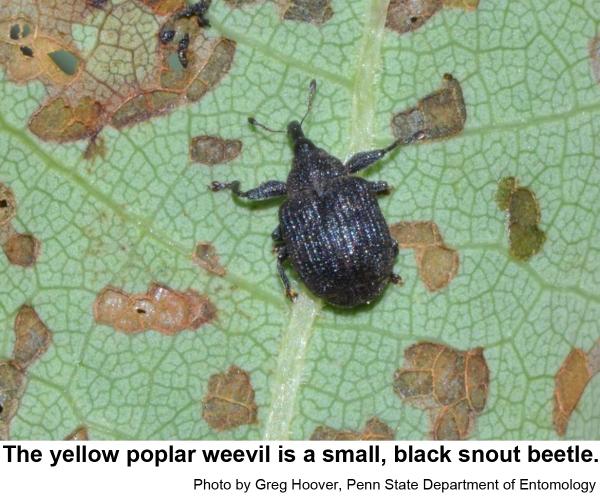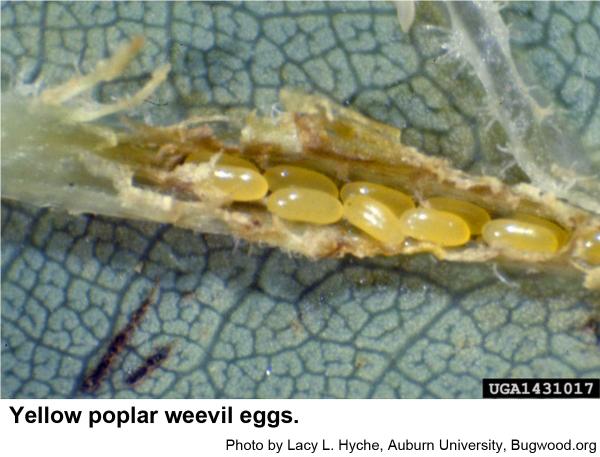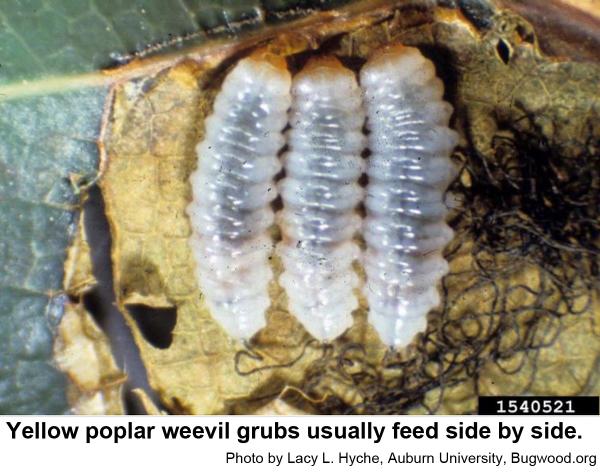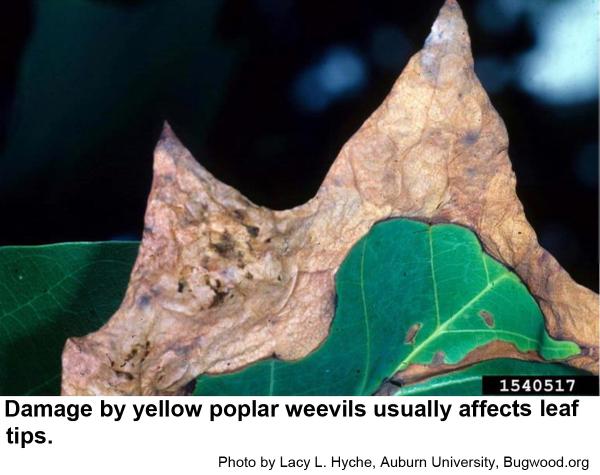Description and Biology
The yellow poplar weevil, Odontopus calceatus, is also called the tuliptree leafminer, magnolia leafminer and the sassafras weevil. These tiny (about 1/8 inch long), black, chunky weevils feed on the buds and leaves. Their tiny, white, legless grubs mine in the leaves. The adults overwinter in leaf litter under the host trees. On warm spring days they fly up and feed on buds and leaves. In May and early June eggs are laid in a row inside the midrib. After hatching, the grubs mine the leaves and cause blotch mines. Usually the blotch starts near the tip of the leaf. When ready to pupate, grubs move to an inflated portion of the mine and spin a spherical silk cocoon that soon turns brown. The inside of the mine is filled with strings of silk and frass. A new generation of adults emerges in mid June. By mid July the adults have disappeared to their hiding places in leaf litter and will remain inactive until spring. Tuliptree may host up to nineteen grubs per leaf. The yellow poplar weevil is a sporadic pest, and outbreaks occur at irregular intervals. We have one generation per year.
Host Plants
Yellow poplar weevils feed on and mine the leaves of tuliptree (yellow poplar), magnolia, sassafras, and sweet bay. Adults feed on the foliage, often removing only the lower epidermis and mesophyl. This feeding causes chlorotic spots and heavily damaged trees appear scorched. Feeding by the newly emerged weevils can be severe causing premature leaf drop. Their damage makes trees unsightly, but probably does not affect its overall health.
Residential Recommendations
Most insecticides labeled for residential landscape use should control yellow poplar weevils especially if sprayed when the adults are feeding in early spring or again when the new adults are feeding in late June. By early July yellow poplar weevils have already descended to the leaf litter to spend the rest of the summer, fall and winter. Tuliptrees can be very tall, and may be out of reach of the sprayers most amateur horticulturists use. Perhaps concerned homeowners can find some comfort in the fact that yellow poplar weevils probably do not cause any permanent damage to infested trees, and that noticeable outbreaks will probably not occur more than two years in a row because parasites build up and limit the population. Because our growing season in North Carolina is so long, even heavily damaged trees can compensate for the early season leafmining by the end of the summer.
Other Resources
- Yellow-Poplar Weevil. Burns, D. P. 1971. USDA Forest Service Forest Pest Leaflet 125. 5 pp.
- Yellow poplar weevil makes presence known in Pennsylvania, mid-Atlantic. Hoover, G. and C. Gill. 2018. Penn State News.
- Yellow Poplar Weevil. Townsend, L. 1994 (revision). Entomology at the University of Kentucky. ENTFACT-414: Yellow Poplar Weevil.
- Extension Plant Pathology Publications and Factsheets
- Horticultural Science Publications
- North Carolina Agricultural Chemicals Manual
For assistance with a specific problem, contact your local N.C. Cooperative Extension Center
Publication date: Dec. 3, 2018
Reviewed/Revised: Oct. 23, 2019
Recommendations for the use of agricultural chemicals are included in this publication as a convenience to the reader. The use of brand names and any mention or listing of commercial products or services in this publication does not imply endorsement by NC State University or N.C. A&T State University nor discrimination against similar products or services not mentioned. Individuals who use agricultural chemicals are responsible for ensuring that the intended use complies with current regulations and conforms to the product label. Be sure to obtain current information about usage regulations and examine a current product label before applying any chemical. For assistance, contact your local N.C. Cooperative Extension county center.
N.C. Cooperative Extension prohibits discrimination and harassment regardless of age, color, disability, family and marital status, gender identity, national origin, political beliefs, race, religion, sex (including pregnancy), sexual orientation and veteran status.






